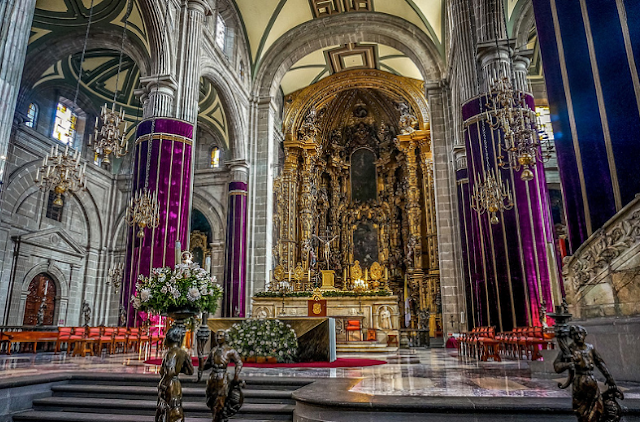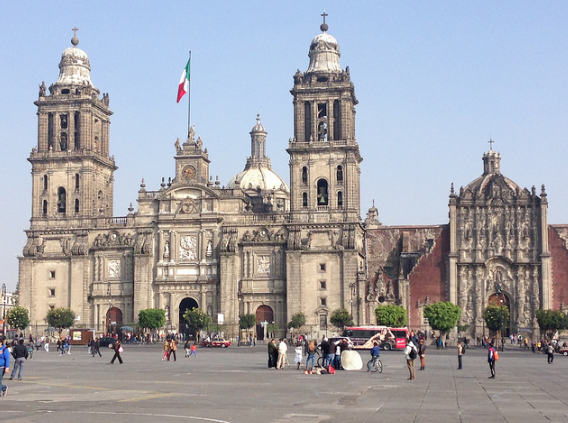Marvel at the Mexico City Metropolitan Cathedral, or relax in Parque Alameda Central, the city offers an unforgettable experience. Don't miss the National History Museum, where Mexico's past comes alive.
 |
| Plaza de la Constitución |
1. Zocalo - The Heart of Mexico City
Zocalo, officially known as Plaza de la Constitución, is one of the largest public squares in the world. Located in the historic center of Mexico City, this bustling plaza is surrounded by colonial-era buildings, including the National Palace and the Metropolitan Cathedral.
Throughout the year, it hosts festivals, concerts, and political events, making it a must-see destination.
Top attractions in Zocalo:
- The Mexican Flag Raising Ceremony - a spectacular sight at sunrise and sunset.
- The Templo Mayor, an ancient Aztec ruin just steps from the plaza.
- Cultural festivals and exhibitions showcasing Mexico's vibrant heritage.
📍 Location: Historic Center, Mexico City
🕒 Best time to visit: Early morning or late evening to avoid the crowds.
 |
| The National Museum |
2. National Museum of Anthropology - A Journey Through Mexican History
The National Museum of Anthropology (Museo Nacional de Antropologia) is Mexico’s most famous museum, housing the largest collection of pre-Columbian artifacts from the Maya, Aztec, and Olmec civilizations.
It is home to the iconic Aztec Sun Stone (Piedra del Sol) and ancient treasures that tell the story of Mexico’s indigenous cultures.
Why go?
✔ Explore 23 exhibition halls filled with archaeological wonders.
✔ See colossal Olmec heads and the feathered serpents of Teotihuacan.
✔ Walk through the Mexican Codices, some of the oldest written records of indigenous civilizations.
📍 Location: Paseo de la Reforma, Chapultepec Park, Mexico City
🕒 Best time to visit: Weekdays to avoid crowds.
 |
| Metropolitan Cathedral |
3. Mexico City Metropolitan Cathedral - A Baroque Masterpiece
Standing proudly on the edge of the Zocalo, the Metropolitan Cathedral (Catedral Metropolitana de la Asunción de María) is the largest and oldest cathedral in Latin America. Built over 250 years, it showcases a blend of Gothic, Baroque, and Neoclassical architecture.
Notable features of the cathedral:
- El Altar de los Reyes - A stunning golden altar.
- Crypt of the Archbishops - Contains the remains of Mexico's religious leaders.
- Bell Tower - Climb to the top for panoramic views of Mexico City.
📍 Location: Zocalo, Mexico City
💲 Admission: Free (there may be a small fee to enter the bell tower)
🕒 Best time to visit: Morning for a peaceful experience.
 |
| Parque Alameda Central |
4. Parque Alameda Central - Mexico's Oldest Public Park
Established in 1592, Parque Alameda Central is Mexico's oldest public park and a perfect place to relax. Located near the Palacio de Bellas Artes, it features beautifully landscaped gardens, fountains, and historical monuments.
What to do at Parque Alameda Central:
🌳 Stroll along the picturesque paths lined with sculptures and fountains.
🎭 See street performers and artists showcasing Mexican culture.
📸 Take photos with the stunning Hemisiclo a Juarez, a neoclassical monument dedicated to Benito Juarez.
📍 Location: Av. Hidalgo, Centro Historico, Mexico City
🕒 Best time to visit: Late afternoon for a pleasant stroll.
 |
| National History Museum |
5. National History Museum - Explore Mexico's Past at Chapultepec Castle
Perched atop Chapultepec Hill, the National History Museum (Museo Nacional de Historia) is housed within the majestic Chapultepec Castle.
This historic castle once served as the residence of Mexican emperors and now houses a vast collection of detailed exhibits, murals, and exhibits that chronicle Mexico's history from the colonial period to the Revolution.
Must-see exhibits:
🏰 The Royal Apartments of Emperor Maximilian and Empress Carlota.
🎨 Diego Rivera's murals depict Mexico's past.
🔭 A panoramic terrace offers stunning views of Mexico City.
📍 Location: Chapultepec Castle, Mexico City
🕒 Best time to visit: Early morning to enjoy the castle before the crowds.
From the historic Zocalo to the cultural treasures of the National Museum of Anthropology, the Mexico City Metropolitan Cathedral, Parque Alameda Central, and the National History Museum, each place offers a glimpse into Mexico’s incredible heritage.
Whether you’re a history buff, architecture lover, or casual traveler, these landmarks should be at the top of your itinerary.
🌟 Travel Tips: Plan your trip early in the morning or on a weekday to enjoy these attractions without the crowds.
📌 Ready to explore Mexico City?
Save this guide for your next adventure and immerse yourself in Mexico City’s rich history and culture! 🌎✈

